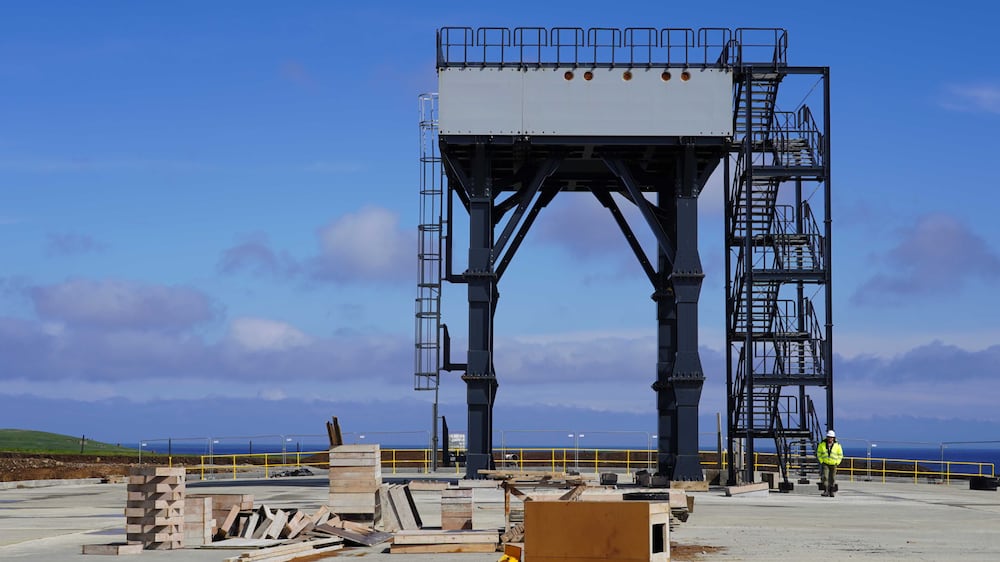Standing at the northernmost inhabited point of Britain at the bottom of the UK’s first ever space rocket launch tower, the reality hits home that the country could soon become a space power.
Looking north, where the next landfall is the frozen Arctic, the skies are wide open and ready to receive the rockets and their satellite cargo.
In the first week of October, jet flames will leap off the Unst peninsula when the first ever commercial rocket launch from Britain powers into the skies above Shetland.
If successful, it will herald the UK’s “industrial revolution in space,” says SaxaVord’s enthusiastic and determined owner Frank Strang.
As Europe’s first functioning spaceport, SaxaVord is already attracting international attention, including from the UAE’s space heaquarters.
By 2025 it is planned for 30 rockets a year to power from SaxaVord spaceport towards low earth orbit, carrying 1,500kg satellite payloads.
While it might be Britain’s northernmost outpost, the island of Unst is set to become the centre of attention for the country’s evolving space economy.
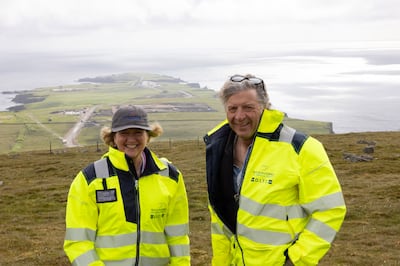
Ready to launch
Today, with its four-legged 12-metre launch-stool, concreted launchpad, huge hangar and evolving infrastructure, SaxaVord is rapidly evolving into a space hub.
But it has been a testing journey for Mr Strang and his loyal team to get there. Politics in Scotland almost sunk the project – with Shetland not considered a favoured location, loans were called in, forcing Mr Strang to re-mortgage his own properties, with his wife Debbie on one occasion seeing off bailiffs from their home.
But he passionately believes that SaxaVord has the potential to become a serious space player.
A former RAF officer, Mr Strang has hand-picked other former air force personnel with the knowledge and professionalism needed to make the project work.
Almost £50 million, much of it gathered through private funding, has been spent on the project so far, including three launch pads on the 87-hectare site and a mission control building. In total the spaceport will cost £150 million, including the cost of lengthening a nearby runway that could allow huge C17 transporters to land with rockets onboard.
“We are building Cape Canaveral!” Mr Strang half-jokes to The National as he strides past his launchpads, the North Sea wind blowing through his hair.
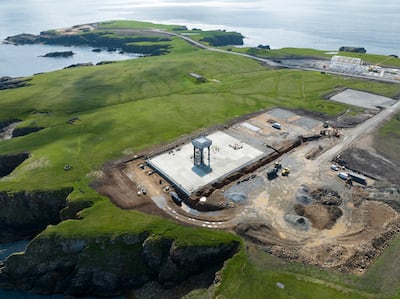
Mission failure
Rocketry and space present serious engineering challenges, with failures inevitable – something SaxaVord insist on highlighting.
Failure was not an outcome much contemplated by Spaceport Cornwall earlier this year when its rocket launched from the wing of a Virgin 747, spun out of control and disintegrated, taking several satellites into the sea.
SaxaVord’s philosophy is more in the spirt of Elon Musk’s SpaceX, which celebrates failure for the lessons learnt, rather than conceding defeat.
“Our first launch could fail on the pad, our second launch could fail, but as long as we, as a spaceport, do our job and nobody gets hurt and we fulfil all the criteria, then it will be a success,” said Mr Strang.
The first rocket, built by German company HyImpulse, will be sub-orbital, heading 50 kilometres skywards and spending 15 minutes in minimal gravity.
The main event will come early next year when a large 29-metre projectile, built by Rocket Factory Augsburg in Germany, lifts off from the launch-stool on a first ever European orbital mission, powering more than 100 kilometres into space, where it will launch satellites.
If that succeeds it will send the signal “to the rest of the world that Britain is in the space game”, said Mr Strang. “But in the launch industry, we're not yet even in the Championship in football parlance, and we've got a long way to go to get into the Premier League, but we can get there and this will be the first step.”
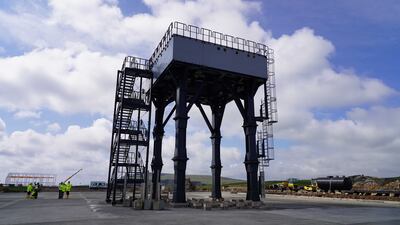
Unst control
Unst’s location is enhanced by its proximity to the North Pole, which means rockets enter low earth orbit at lower speeds than from the Equator and thus require less fuel for braking.
The island also has many qualities that make it 30 per cent more favourable than any other UK location for vertical launches, according to a report backed by the UK Space Agency.
The area provides 15 per cent of the UK’s oil and gas, which means a huge infrastructure is in place with many daily flights to the island and, more importantly, two ferries, one of which is cleared to ship hazardous loads.
That will allow the transport of rocket parts that fit into regular shipping containers, as well as satellites and provisions for the 50 personnel who will man the mission control centre, complete with its Cape Canaveral-like banks of screens.
Unlike Norway, its competitor, Unst does not experience the freezing climate of the Arctic Circle.
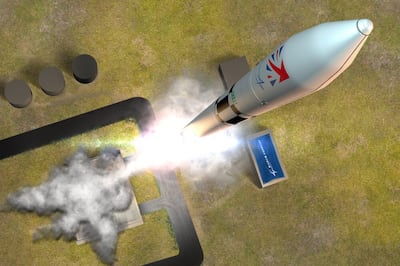
Space Emirates
The strong suggestion that SaxaVord will become an international space hub is attracting worldwide interest, including from the UAE.
Mr Strang lauds the Emirates' space strategy as a way to diversify from oil and gas and train young people.
He was approached by Salem Al Marri, director general of the Mohammed Bin Rashid Space Centre, earlier this year.
“He understood what we were doing and expressed an interest in finding a way to work together,” said Mr Strang.
“We're also in dialogue with the UAE Space Agency, as we share the same vision. Our economy here in Shetland has been based on oil and gas and we're now diversifying. I've looked at the UAE space strategy and it presses every button, it's a world leader.”
There is a suggestion that young Emirati space technicians could visit SaxaVord to learn how a spaceport is run, with a view to opening one in the UAE.
“It's about the cross-fertilisation of ideas and tapping into joint initiatives, and it's the long-term vision they have which is very practical. We can learn from each other and support each other.”
Northern lights
Alongside safety, location is the key factor in running a successful spaceport. Beyond the northern tip of Unst, there is essentially no landmass until the Arctic.
“We're right on the most northern tip of the UK, so it's the safest, and it gives easy access to the trajectories that we require,” said Scott Hammond, the operations director. “It's all about location, location, location.”
The nearest inhabited home is two kilometres away, and Unst has a population of 632, of whom most – but not all – approve of having a space station on their island.
Mr Hammond, a former RAF Tornado pilot, is heralded by his boss as the UK’s leading spaceport operator, and has built up a wealth of knowledge.
“I was a qualified weapons instructor; that meant I understand things like collateral damage estimates, calculations for explosives, missile technology, how to track missiles and flight management systems,” Mr Hammond said.
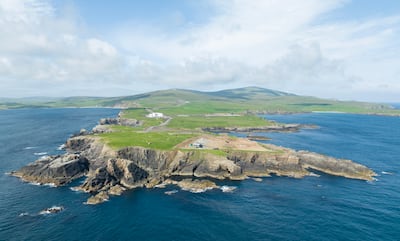
Rocket tears
While a combat veteran jet fighter pilot on the surface, he also admits to the likelihood of “shedding a tear” if the October launch succeeds.
“After that, I do think it's going to be absolutely massive, especially for the UK space industry and for us.”
He may well be right. There is strong interest being shown in Unst, not just from the US and UAE, but also from Saudi Arabia, Germany and France.
Its position been enhanced by Russia’s invasion of Ukraine, which has seen nearly all foreign satellite players withdraw from the Moscow-operated Baikonur cosmodrome in Kazakhstan.
There is also much greater military interest in space since the war began. “There's going to be more and more satellites flung up into space for various purposes, and future wars are going to be fought in space,” said Mr Strang.
There is a suggestion that both the UK and US military will look with even greater interest on SaxaVord, which was an RAF base until Mr Strang purchased it in 2004, complete with all its outbuildings and accommodation.
His original vision had been to host tourists for birdwatching or whale-spotting, but seven years ago, as Britain announced its interest in space, he explored the idea of SaxaVord’s viability.
Many greeted his vision with disbelief, as he embarked on a long and challenging mission. “For my wife and I, and my family, at times it's been a horrific journey with our noses really pressed up against the wall, but never once have I felt we're not going to get there.”
